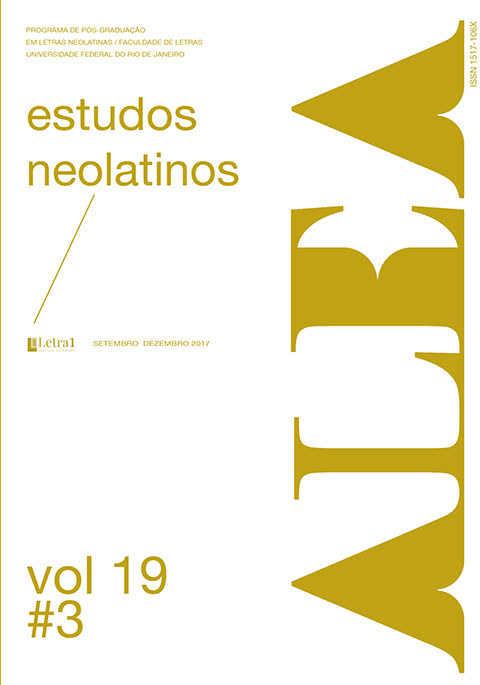Silvas em três tempos: emulação e engenho em Estácio, Poliziano, Quevedo
DOI:
https://doi.org/10.1590/1517-106X/2017193525537Abstract
Este trabalho tem por objetivo observar o uso do termo Silua para nomear uma composição poética curta, de tom laudatório e de caráter espontâneo, desde os cinco livros de Estácio até os encômios eruditos de Angelo Poliziano. A partir da consideração de alguns dos seus empregos na Antiguidade, em Varrão, Quintiliano e Suetônio, pretende-se discutir as características das Siluae de Estácio conforme recuperadas por Poliziano; por fim, aponta-se para a continuidade e metamorfose do termo na produção poética em línguas vernáculas, através das Silvas de Quevedo.
References
CANCIK, Hubert. Untersuchungen zur lyrischen des P. Papinius Statius. Hildesheim: Georg Olms, 1965.
CLOGAN, Paul M. fte Renaissance Comentators on Statius. In: INTERNATIONAL CONGRESS OF NEO-LATIN STUDIES, 7, 1988, Toronto. Acta Conventus Neo-LatiniTorontonensis: proceedings of the seventh International Congress of Neo- Latin Studies. Toronto, Center for the Medieval and Early Renaissance Studies, 1991, p.273-280.
COLEMAN, Kathleen M. Statius Silvae IV. Oxford: Oxford University, 1988. DELLANEVA, Joann. Ciceronian controversies. Cambridge, Mass.; London: Harvard University, 2007.
DOMINIK, William J. Epigram and Occasional Poetry: Social Life and Values in Martial's Epigrams and Statius' Silvae. In: ZISSOS, Andrew. A Companion to the Flavian Age of Imperial Rome. Malden, MA: John Wiley & Sons, 2016. p. 412-33.
GARTHWAITE, John. fte Panegyrics of Domitian in Martial Book 9. Ramus 22, 1993, p. 79-102.
HARDIE, Alex. Statius and the Silvae: poets, patrons and epideixis in the Graeco- Roman world. Liverpool: David Brown, 1983.
HOLFORD-STREVENS, Leofranc. In search of Poplios Papinios Statios. Hermathena, 168, 2000, p.39-54.
KALLENDORF, Hilaire; KALLENDORF, Craig. Conversations with the Dead: Quevedo and Statius, Annotation and Imitation. Journal of the Warburg and Courtauld Institutes, Vol. 63, p. 131-168, 2000.
JONES, Brian W. The Emperor Domitian. London: Routledge, 1992.
LAGUNA-MARISCAL, Gabriel. Statius' Silvae 3.5.44-49 and the genre of Ovid's Heroides. Rheinisches Museum fürPhilologie, NeueFolge, 137. Bd., H. 3/4, 1994, p. 352-357.
LOONEY, Dennis. Compromising the Classics: Romance Epic Narrative in the Italian Renaissance. Detroit: Wayne State University, 1996.
MCLAUGHLIN, Martin L. fte Dispute between Poliziano and Cortesi. In: MCLAUGHLIN, Martin L. Literary Imitation in the Italian Renaissance. Oxford: Oxford University, 1996.
MCNELIS, Charles. Looking at the forest? fte Silvae and Roman Studies: afterword. Arethusa, 40, 2, Spring, 2007, p. 279-287.
MENGELKOCH, Dustin Larry. Papinian mutability: Statius and early modernity. Tese de doutorado. North Carolina at Chapel Hill. Department of English and Comparative Literature, 2010.
NAUTA, Ruurd. Poetry for patrons: literary communication in the age of Domician. Leiden: Brill, 2002.
NEWLANDS, Carole. Statius, poet between Rome and Naples. London: Bristol Classical, 2012.
NEWLANDS, Carole. Statius and the Poetics of Empire. Cambridge: Cambridge, 2002. PLEKET, H.W. Domitian, the Senate and the Provinces. Mnemosyne, n.14, 1961, p. 296-315.
POLIZIANO, Angelo. Silvae. Ed. and trans. Charles Fantazzi. Cambridge, Massachussetts: Harvard University, 2004.
SOUTHERN, Pat. Domitian: Tragic Tyrant. London; New York: Routledge, 2009. STATIUS. Silvae . Ed. D.R. Shackleton Bailey. Cambridge, Massachussets: Harvard University, 2003.
TANNER, R. G. Epic Tradition and Epigram in Statius ANRW, II.32.5, 1986, p. 3020-3046.
WATERS, K. H. fte Character of Domitian. Phoenix, n.18, 1964. p. 49-77. WHITE, Peter. Presentation and Dedication of the Silvae and Epigrams. JRS, 64: p. 40-61, 1974.
WHITE, Peter. fte Friends of Martial, Statius, Pliny, and the Dispersal of Patronage. HSCP, 79, p. 265-300, 1975.
WRAY, David. Wood: Statius' Silvae and the Poetics of Genius. Arethusa , v. 40, n.2, Spring 2007, p. 127-143.
ZISSOS, Andrew (ed.). A Companion to the Flavian Age of Imperial Rome. Malden/ MA: Wiley-Blackwell, 2016.
Downloads
Published
Issue
Section
License
THE AUTHOR/S confirm/s his, her or their participation in all stages of work preparation: 1) Conception, project, bibliographical research, analysis and interpretation of data; 2) Writing and reviewing the manuscript; 3) Approval of the final version of the manuscript for publication; 4) Responsibility for all aspects of the work and guarantee for the accuracy and integrity of any part of the work. The submission of works implies the immediate cession, without onus, by all authors, of publication rights to the journal Alea, licensed under CC BY (https://creativecommons.org/licenses/by/4.0/). The authors are fully responsible for the content of the article and continue to hold all copyrights for subsequent publications of it, and should, if possible, include the reference to the first publication in the journal. Alea does not commit to returning received contributions. Authors of articles, reviews or translations will receive a copy of the journal.

